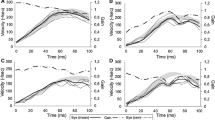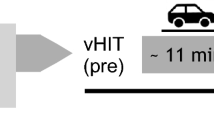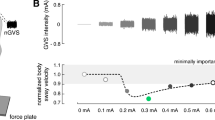Abstract
In order to determine the effect of figure skating on the functional plasticity of the vestibular system, we quantified vestibulo-ocular reflex (VOR) and motion sickness (MS) intensity in 11 female figure skaters and 11 matched control subjects. Vestibular stimulation consisted of three cycles of sinusoidal rotation (0.025 Hz, ±60°/s) and two velocity steps of 60°/s (acceleration 60°/s2). Nauseogenic stimulation consisted of a constant velocity (60°/s) off vertical axis rotation (OVAR) using a 15° tilt angle. Subjective sickness symptoms were rated immediately after OVAR with the Pensacola diagnostic index. During sinusoidal stimulations, the skaters’ VOR, as compared with that of the controls, demonstrates a gain that is 27% lower (0.44 ± 0.12 vs. 0.58 ± 0.10; P < 0.01) and a phase advance (10 ± 12° vs. −0.3 ± 6.4°; P < 0.05). During velocity steps, the VOR gain is 32% lower among the skaters (0.52 ± 0.14 vs. 0.71 ± 0.12; P < 0.01), but there is no difference in time constant (10.8 ± 1.8 s vs. 10.5 ± 2.7 s; P = 0.78). Nauseogenic stimulation evokes significantly less MS in figure skaters than in control subjects (2.8 ± 2.8 vs. 16.2 ± 13.7; P < 0.01). Quantitative alterations in VOR parameters observed in figure skaters probably result from vestibular habituation induced by repeated unusual stimulations when practicing figure skating.






Similar content being viewed by others
References
Aschan G (1954) Response to rotatory stimuli in fighter pilots. Acta Otolaryngol 116:24–31. doi:10.3109/00016485409130269
Bahill AT, McDonald JD (1983) Frequency limitations and optimal step size for the two-point central difference derivative algorithm with applications to human eye movement data. IEEE Trans Biomed Eng 30:191–194. doi:10.1109/TBME.1983.325108
Baloh RW, Henn V, Jäger J (1982) Habituation of the human vestibulo-ocular reflex with low-frequency harmonic acceleration. Am J Otolaryngol 3:235–241. doi:10.1016/S0196-0709(82)80061-6
Blair S, Gavin M (1979) Response of the vestibulo-ocular reflex to differing programs of acceleration. Invest Ophtalmol Vis Sci pp 1086–1090
Bos JE, Bles W (2002) Theoretical considerations on canal-otolith interaction and an observer model. Biol Cybern 86:191–207. doi:10.1007/s00422-001-0289-7
Bos JE, Bles W, de Graaf B (2002) Eye movements to yaw, pitch, and roll about vertical and horizontal axes: adaptation and motion sickness. Aviat Space Environ Med 73:436–444
Clement G, Courjon JH, Jeannerod M, Schmid R (1981) Unidirectional habituation of vestibulo-ocular responses by repeated rotational or optokinetic stimulations in the cat. Exp Brain Res 42:34–42. doi:10.1007/BF00235726
Clement G, Deguine O, Parant M, Costes-Salon MC, Vasseur-Clausen P, Pavy-LeTraon A (2001) Effects of cosmonaut vestibular training on vestibular function prior to spaceflight. Eur J Appl Physiol 85:539–545. doi:10.1007/s004210100494
Clement G, Flandrin JM, Courjon JH (2002) Comparison between habituation of the cat vestibulo-ocular reflex by velocity steps and sinusoidal vestibular stimulation in the dark. Exp Brain Res 142:259–267. doi:10.1007/s00221-001-0930-7
Cohen H, Cohen B, Raphan T, Waespe W (1992) Habituation and adaptation of the vestibuloocular reflex: a model of differential control by the vestibulocerebellum. Exp Brain Res 90:526–538. doi:10.1007/BF00230935
Collins W (1966) Vestibular responses from figure skaters. Aerosp Med 37:1098–1104
Dai M, Kunin M, Raphan T, Cohen B (2003) The relation of motion sickness to the spatial–temporal properties of velocity storage. Exp Brain Res 151:173–189. doi:10.1007/s00221-003-1479-4
Denise P, Darlot C, Ignatiew-Charles P, Toupet M (1996a) Unilateral peripheral semicircular canal lesion and off-vertical axis rotation. Acta Otolaryngol 116:361–367. doi:10.3109/00016489609137858
Denise P, Etard O, Zupan L, Darlot C (1996b) Motion sickness during off-vertical axis rotation: prediction by a model of sensory interactions and correlation with other forms of motion sickness. Neurosci Lett 203:183–186. doi:10.1016/0304-3940(96)12303-X
DiZio P, Lackner JR (1991) Motion sickness susceptibility in parabolic flight and velocity storage activity. Aviat Space Environ Med 62:300–307
Graybiel A, Wood CD, Miller EF, Cramer DB (1968) Diagnostic criteria for grading the severity of acute motion sickness. Aerosp Med 39:453–455
Green AM, Angelaki DE (2004) An integrative neural network for detecting inertial motion and head orientation. J Neurophysiol 92:905–925. doi:10.1152/jn.01234.2003
Jäger J, Henn V (1981) Habituation of the vestibulo-ocular reflex (VOR) in monkey during sinusoidal rotation in the dark. Exp Brain Res 41:108–114. doi:10.1007/BF00236599
Koizuka I (2003) Adaptive plasticity in the otolith-ocular reflex. Auris Nasus Larynx 30(Suppl):S3–S6. doi:10.1016/S0385-8146(02)00117-7
Lee MY, Kim MS, Park BR (2004) Adaptation of the horizontal vestibuloocular reflex in pilots. Laryngoscope 114:897–902. doi:10.1097/00005537-200405000-00021
McCabe BF (1960) Vestibular suppression in figure skaters. Trans am acad ophtalmol otolaryngol 64:264–268
Osterhammel P, Terkildsen K, Zirstorff K (1968) Vestibular habituation in ballet dancers. Acta Otolaryngol 66:221–228. doi:10.3109/00016486809126289
Quarck G, Denise P (2005) Caractéristiques du réflexe vestibulo-oculaire chez les gymnastes. Science et Motricité
Quarck G, Etard O, Darlot C, Denise P (1998) Motion sickness susceptibility correlates with otolith- and canal-ocular reflexes. Neuroreport 9:2253–2256. doi:10.1097/00001756-199807130-00019
Quarck G, Etard O, Oreel M, Denise P (2000) Motion sickness occurrence does not correlate with nystagmus characteristics. Neurosci Lett 287:49–52. doi:10.1016/S0304-3940(00)01140-X
Robinson DA (1981) The use of control systems analysis in the neurophysiology of eye movements. Annu Rev Neurosci 4:463–503. doi:10.1146/annurev.ne.04.030181.002335
Schwarz U, Henn V (1989) Vestibular habituation in student pilots. Aviat Space Environ Med 60:755–761
Shupak A, Kerem D, Gordon C, Spitzer O, Mendelowitz N, Melamed Y (1990) Vestibulo-ocular reflex as a parameter of seasickness susceptibility. Ann Otol Rhinol Laryngol 99:131–136
Tanguy SG, Quarck GM, Etard OM, Gauthier AF, Denise P (2008) Are otolithic inputs interpreted better in figure skaters? Neuroreport 19:565–568
Tschiassny K (1957) Studies concerning vestibular factors in the ballet dancer, the pigeon and the blind person. Trans Am Acad Ophtalmol Otolaryngol pp 503–506
Usami S-I, Igarashi M, Ishii M, Hozawa J (1988) Unidirectional vestibular habituation in the squirrel monkey. The time course and its influence on optokinetic nystagmus. Acta Otolaryngol Suppl 106:124–129. doi:10.3109/00016488809107379
Yagi T, Sekine S, Shimizu M (1983) Age-dependent changes in the gains of the vestibulo-ocular reflex in humans. Adv Otorhinolaryngol 30:9–12
Acknowledgments
We would like to thank Yannick Liégard for technical assistance in modification of the rotating chair and Valérie Fong for the revision of the English.
Author information
Authors and Affiliations
Corresponding author
Rights and permissions
About this article
Cite this article
Tanguy, S., Quarck, G., Etard, O. et al. Vestibulo-ocular reflex and motion sickness in figure skaters. Eur J Appl Physiol 104, 1031–1037 (2008). https://doi.org/10.1007/s00421-008-0859-7
Accepted:
Published:
Issue Date:
DOI: https://doi.org/10.1007/s00421-008-0859-7




